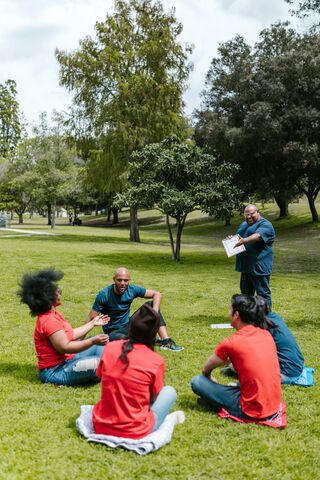Empathy
Well-being Programs Should Build Relatedness and Connection
Using empathy practice for well-being in the workplace.
Posted June 22, 2022 Reviewed by Gary Drevitch
Key points
- With employees across the globe struggling with mental health, well-being programs at work are essential.
- Well-being programs centered on perks and self-care fail to address the core of human well-being dependent on relatedness and connection.
- Empathic behaviors amongst colleagues nurture well-being and build connection.

With workers across the globe struggling with their mental health, well-being programs on the job are essential. In June 2020, the Centers for Disease Control and Prevention (CDC) found that 41 percent of Americans over age 18 struggled with mental health or substance abuse; 31 percent reported symptoms of anxiety and depression, compared to 11 percent the previous year; 26 percent reported symptoms of trauma or a stressor-related disorder; 13 percent had started or increased substance use; and 11 percent had seriously considered suicide. In the U.K., in 2020/2021, work-related stress, depression, or anxiety accounted for 50 percent of all work-related ill-health (Labor Force Survey, 2021). Since working people spend about one-third of their time at work, well-being programs offer a unique opportunity to make a difference.
Compromised well-being presents a double-edged sword for organizations since well-being and performance are inextricably linked. Working conditions and work environment affect a person’s mental well-being. Correspondingly, mental well-being impacts a person’s performance at work. The good news is that changes to the working environment and conditions that positively impact mental well-being will also improve work performance (Crawford, Graveling, Cowie & Dixon, 2009). Hence, the great need for effective well-being programs in the workplace right now.
Not all well-being programs are created equal, though. Many focus on perks and self-care, such as exercise and relaxation routines, healthy snacks at work, and incentives to quit smoking, to name a few. These are laudable and likely to be valued. However, a recent Harvard Business Review article highlights the limitations of well-being programs focused heavily on self-care. These programs don’t deal with the whole issue at hand, and may perpetuate, even drive, a cycle of mental health issues.
Well-being is not achieved alone. We are social beings, dependent on attention and connection. Relatedness is considered one of three psychological needs essential for building extraordinary workplaces and high-performing teams. The other two are autonomy and competence. Self-care perks focus on self and are usually achieved in isolation or as individual activities alongside others. Well-being programs need to address and build relatedness and connections amongst people.
Fostering well-being at work through empathy
One way to nurture well-being and build connection is through empathic behaviors amongst staff. A 2021 report from Businessolver makes a strong case for empathy in the workplace to mitigate these troubling statistics. Unfortunately, their results still show that communication and assistance for mental health are challenging for most workplaces, and empathy is still lacking.
The Cancer Association of South Africa (CANSA) is ahead of its game in this regard. Over the last six years, they have piloted and implemented the method we co-created, called Empathic Intervision, which focuses on collegial, empathic peer support as a core pillar of its well-being strategy. In regular monthly Zoom gatherings, all staff in the organization put down their tools and spend an hour and a half connecting, creating mutual understanding, and addressing issues together.
The program started out when the organization consulted with us to help them find a way to support service delivery staff to care for themselves while providing empathic care to cancer patients and their families. We conducted a pilot with an adapted version of our program according to their assessed needs. Management and staff alike assessed the results of the pilot and saw that the organization would benefit if all staff worked in this way. The service delivery staff found the empathic language and practices they learned helped their own well-being, and improved interactions within their department and between themselves, their volunteers, their patients, and patient families. However, they needed the language to be common between departments to really harvest the benefits.
Towards the end of 2020, all staff were introduced to the practice. Initially, the meetings were held by trained facilitators as a way to introduce them to the skills and practice. Thereafter, a cohort of committed staff was trained as internal facilitators.
Empathic Intervisions are versatile and can be applied to multiple strategic objectives, such as well-being, decision making, or co-creation. One thing is common: They build peer connection and learning. Each intervision, or series or program of intervisions, starts with a specific topic and intention related to the topic. In a well-being program, the topic will address well-being issues in the organization, and the intention of each meeting relates to a specific well-being issue presenting itself there.
Empathic Intervisions address well-being on four levels. Topics and intentions are explicitly chosen to draw awareness to and deepen understanding of prevailing well-being challenges and opportunities. Furthermore, the method makes use of five integrative empathy skills crafted, on the one hand, to guide personal and group reflection and interaction, and on the other, to encourage and enable mutual connection, understanding, and tolerance. Finally, each individual intervision closes with the practice of empathic creativity, harvesting significant change moments as actionable outcomes. This ensures that intentions and insights lead to behavior change.
Research shows how serving others helps individual well-being, not only emotionally but also physically. In fact, physician scientists Stephen Trzeciak and Anthony Mazzarelli's research points to serving others as a "wonder drug" for one's own well-being. Empathic Intervisions create a dedicated space in the working schedule to mutually attend to and serve each other. They also foster a habitual pattern and tone of interaction that holds space for each other. In this way, a wellness program is dedicated to the mutual well-being of employees through interrelatedness and connection.
References
Crawford, J. O., Graveling, R. A., Cowie, H., Dixon, K., & Laura MacCalman Research Committee. (2009). Institute of Occupational Medicine. Edinburgh, Scotland (Rapporteur).
Czeisler MÉ , Lane RI, Petrosky E, et al. Mental Health, Substance Use, and Suicidal Ideation During the COVID-19 Pandemic — United States, June 24–30, 2020. MMWR Morb Mortal Wkly Rep 2020;69:1049–1057. DOI: http://dx.doi.org/10.15585/mmwr.mm6932a1external icon
Lelliott, P., Tulloch, S., Boardman, J., Harvey, S., & Henderson, H. (2008). Mental health and work. Retrieved from gov.uk/government/uploads/system/uploads/attachment_data/file/212266/hwwb-mental-health-and-work.pdf
Stansfeld, S., Clark, C., Bebbington, P., King, M., Jenkins, R., & Hinchliffe, S. (2016). Chapter 2: Common mental disorders. In S. McManus, P. Bebbington, R. Jenkins, & T.Brugha (Eds.), Mental health and wellbeing in England: Adult Psychiatric Morbidity Survey 2014. Leeds: NHS Digital.
hbr.org/2022/04/stop-framing-wellness-programs-around-self-care
empathicintervision.com/2019/09/18/the-peer-to-peer-practice-of-empathic-intervision/




